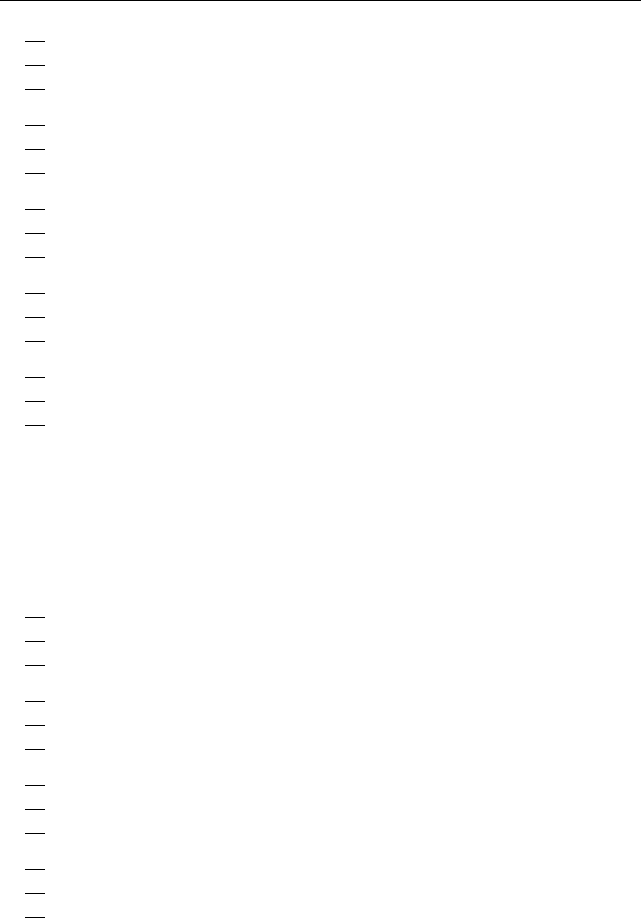Byon A. Basic Korean: A Grammar and Workbook
Подождите немного. Документ загружается.


172 Unit 21: The endings -O㦒PඥGỆ㡞㣪 and -O㦒Pඥ₢㣪f
The -O㦒Pඥ₢㣪f ending can be used for the past tense as well. Consider
the following sentences:
䙊㧊GἆῃG㹾⯒G㌖㦚₢㣪f “Do you think that Paul finally bought the
car?”
㞺✲⮮ṖG䞲ῃ㠦㍲G☢㞚㢪㦚₢㣪f “Do you think that Andrew returned
from Korea?”
The repeated use of -O㦒Pඥ₢㣪fGcan be used to express alternative ques-
tions. For instance, consider the following sentences:
䞲ῃG㦢㔳㦚Gⲏ㦚₢㣪fG㭧ῃG㦢㔳㦚Gⲏ㦚₢㣪f “Shall (I/we) eat Korean
food or Chinese food?”
䆪⹎❪G 㡗䢪⯒G ⽒₢㣪fG ⪲ⰾ䕇G 㡗䢪⯒G ⽒₢㣪f “Shall (I/we) see a
comedy or romantic movie?”
㰧㦒⪲G Ṟ₢㣪fG ☚㍲ὖ㦒⪲G Ṟ₢㣪f “Shall (I/we) go home or to the
library?”
Notice that while the predicate (e.g., shall (I/we) eat . . . ) is used only once
in English, the predicate is repeated in Korean.
Meanwhile, when -O㦒Pඥ₢㣪f is used with other verbs such as 䞮┺
“do” and ㌳ṗ䞮┺ “think,” it expresses the speaker’s provisional idea
regarding what s/he may do, corresponding to “I am thinking of doing
something” in English. Consider the following sentences:
㩖☚G䞲ῃ㠦GṞ₢G䟊㣪. “I am also thinking of going to Korea.”
㩖⎗㦚G ]G 㔲㠦G ⲏ㦚₢G 䟊㣪. “(I) am thinking of having dinner at 6
o’clock.”
┺㦢G 䞯₆㠦 䞲ῃ㠊⯒G ⺆㤎₢G ㌳ṗ䟊㣪. “(I) am thinking of learning
Korean next semester.”
Exercises
Key vocabulary for Unit 21 exercises
Ṗ┺ to go
Ṗ㑮 singer
Ṗ⯊䂮┺ to teach
Ṛ䢎㌂ nurse
ỆⰂ road/street
Ὃ䟃 airport
⁎Ⱒ⚦┺ to quit
₆㧦 journalist
9780415774871_C 21.indd 1729780415774871_C21.indd 172 7/4/2008 1:39:11 PM7/4/2008 1:39:11 PM

Unit 21: The endings -O㦒PඥGỆ㡞㣪 and -O㦒Pඥ₢㣪f 173
₆㹾 train
₾⊭䞮┺ to be clean
⋶㝾 weather
⏖┺ to play
┺㦢 next
╖䞯ᾦ university
▻┺ to be hot (weather)
☫┺ to help
✹┺ to listen
Ⱎ㔲┺ to drink
ⰱ㧞┺ to be delicious
⳿㑮 carpenter
⹕┺ to believe
㊮┺ to be busy
room
⺆㤆 actor
⺆㤆┺ to learn
⺇䢪㩦 department store
゚┺ to be congested
゚㕎┺ to be expensive
㌂┺ to buy
㌊┺ to live
㌳㧒 birthday
㞚䂾 morning
㟓㌂ pharmacist
㢍 clothes
㣪Ⰲ䞮┺ to cook
㡺⓮ today
㡺┺ to come
㦮㌂ medical doctor
㦢㔳 food
㧒 work
㧒⽎ Japan
㧦┺ to sleep
㩚䢪䞮┺ to make a phone call
㫆㣿䞮┺ to be quiet
㫡㞚䞮┺ to like
㭒 week
㰧 house
㿫ῂ soccer
㿻┺ to be cold (weather)
䂲ῂ✺ friends
䌖┺ to ride
9780415774871_C 21.indd 1739780415774871_C21.indd 173 7/4/2008 1:39:11 PM7/4/2008 1:39:11 PM

174 Unit 21: The endings -O㦒PඥGỆ㡞㣪 and -O㦒Pඥ₢㣪f
䞲ῃ㠊 the Korean language
䡫 older brother
䢪㧻䛞 cosmetics
䣢㌂㤦 office worker
䦦Ⰲ┺ to be cloudy (weather)
Exercise 21.1
With the words below construct Korean sentences, using -O㦒PඥG Ệ㡞㣪.
Example: 䏶Ⱎ㓺SG㌂ὒSGⲏ┺
= 䏶Ⱎ㓺⓪G㌂ὒ⯒Gⲏ㦚GỆ㡞㣪
1 㩖SG㟒ῂSG䞮┺
2 㩖SG䞒㞚⏎SG䂮┺
3 㤆ⰂSG䌲ῢ☚SG⺆㤆┺
4 㭚ⰂSG㠦㠊⪲゛SG䞮┺
5 Ⰲ㌂SG㧒SG⊳⌊┺
6 䌊⻢ⰂSG䞯ᾦG㤊☯㧻SG⥆┺
7 ㌂⧒SG㰧SG㧞┺
8 ◆㧊キSG䂲ῂSG₆┺Ⰲ┺
9 ⪲⩢SGⶒSG⊩㧊┺
10 䙊SG☞SG⳾㦒┺
Exercise 21.2
Change each sentence with -O㦒PඥGỆ㡞㣪 and translate the sentence, as
shown below:
Example: 䞯ᾦ㠦GṖ㣪
= 䞯ᾦ㠦GṞỆ㡞㣪 “(I) will (probably) go to school”
1 Ὃ䟃㠦㍲G䌳㔲⯒G䌖㣪.
2 䞲ῃ㠊⯒GṖ⯊㼦㣪.
3 ┺㦢G㭒㠦G㧒㦚G⁎Ⱒ⛂㣪.
4 䂲ῂ✺㧊⧧G㰧㠦㍲G⏖㞚㣪.
5 䡫㦮GⰦ㦚G⹕㠊㣪.
6 䂲ῂ㦮G㌳㧒G䕢䕆㠦GṖ㣪.
7 ⌊㧒G⋶㝾⓪G㿪㤢㣪.
8 㞚䂾㠦G㫆ₛG䟊㣪.
9 㩲㧊㓾㦖Gザ㣪.
10 䢪㧻䛞㦚G㌂㣪.
9780415774871_C 21.indd 1749780415774871_C21.indd 174 7/4/2008 1:39:11 PM7/4/2008 1:39:11 PM

Unit 21: The endings -O㦒PඥGỆ㡞㣪 and -O㦒Pඥ₢㣪f 175
Exercise 21.3
Write the dictionary form of the following irregular verbs below (refer to
Unit 19 for irregular predicates).
Example: ⋶㝾ṖG㿪㤎GỆ㡞㣪
= 㿻┺
1 䞲ῃ㠦㍲G㌊Ệ㡞㣪.
2 䞲ῃG⏎⧮⯒G✺㦚GỆ㡞㣪.
3 ₖ䂮ṖGⰺ㤎GỆ㡞㣪.
4 䂲ῂ⯒G☚㤎GỆ㡞㣪.
5 ⼧㧊G⋮㦚GỆ㡞㣪.
6 䞮⓮㧊G䕢⧚GỆ㡞㣪.
7 ⏎⧮⯒G⯒GỆ㡞㣪.
8 ⁎G㌂㔺㦚G㞢Ệ㡞㣪.
9 ☞㦚G⻢GỆ㡞㣪.
10 ⺆ṖGἶ䝢GỆ㡞㣪.
Exercise 21.4
Change each sentence with -O㦒PඥGỆ㡞㣪 and translate the sentence.
Example: 㫊㧊G⹎ῃG㌂⧢㧊㠦㣪
= 㫊㧊G⹎ῃG㌂⧢㧒GỆ㡞㣪 “John is probably an American”
1 㧒⩞㧎㧊GṖ㑮㡞㣪.
2 㺆㓺ṖG㠪㰖┞㠊㡞㣪.
3 Ⰲ❪㞚ṖG㦮㌂㡞㣪.
4 㩲㧊㓾㧊G₆㧦㡞㣪.
5 㠪㰖ṖG㟓㌂㡞㣪.
6 ぢ⧒㧊㠎㧊G䣢㌂㤦㧊㡞㣪.
7 㭚ⰂṖGṚ䢎㌂㡞㣪.
8 ㌂㧊ⴂ㧊G⳿㑮㡞㣪.
9 㧊㌂㧊G㟋䄺㤆Ⲓ㧊㠦㣪.
10 䐆㧊G⺆㤆㡞㣪.
9780415774871_C 21.indd 1759780415774871_C21.indd 175 7/4/2008 1:39:11 PM7/4/2008 1:39:11 PM

176 Unit 21: The endings -O㦒PඥGỆ㡞㣪 and -O㦒Pඥ₢㣪f
Exercise 21.5
Translate the following Korean sentences into English:
Example: 㤆ⰂG䞲ῃ㠦GṞ₢㣪f
= “Shall we go to Korea?”
1 㩲ṖGニ㦚G㌊₢㣪f
2 㩲ṖG㧊G㠦㍲G㧮₢㣪f
3 㩲ṖG㣪Ⰲ䞶₢㣪f
4 㩖䧂ṖG䌳㔲⯒G䌞₢㣪f
5 㩖䧂ṖG⁎G䂲ῂ⯒G☚㤎₢㣪f
6 ⋶㝾ṖG䦦Ⰺ₢㣪f
7 㦢㔳㧊Gⰱ㧞㦚₢㣪f
8 㢍㧊G゚㕖₢㣪f
9 㠦Ⰳ㧊G䌲ῢ☚⯒G⺆㤎₢㣪f
10 㩲㔲䃊ṖGⓊ㣫㠦G㢂₢㣪f
Exercise 21.6
Change each sentence with -O㦒Pඥ₢㣪f Then, translate the sentence as
shown below:
Example: ぢ⧮✲ṖG㧦㩚Ệ⯒G䌖㣪
= ぢ⧮✲ṖG㧦㩚Ệ⯒G䌞₢㣪f “Do (you) think that Brad
will ride a bicycle?”
1 ㍶㌳┮㧊G㨂㯞⯒G✺㠊㣪.
2 㞶┞ṖG㧒⽎G㹾⯒G㫡㞚䟊㣪.
3 㩲㧚㓺ṖG㿫ῂ⯒G䟊㣪.
4 㞾Ⰲ㓺ṖG㩚䢪䟊㣪.
5 ⪲⩢㓺ṖG₆㹾⯒G䌖㣪.
6 ⁖⩢㧊G㢖㧎㦚GⰞ㎪㣪.
7 㰧㧊G㫆㣿䟊㣪.
8 ⺇䢪㩦㧊G⼒㣪.
9 ⋶㝾ṖG▪㤢㣪.
10 ỆⰂṖG₾⊭䟊㣪.
9780415774871_C 21.indd 1769780415774871_C21.indd 176 7/4/2008 1:39:12 PM7/4/2008 1:39:12 PM

UNIT 22
Prenouns
Linguistic elements whose primary function is to modify the target noun
are called “modifiers.” Modifiers in Korean include prenouns, adjectives,
and relative clauses. The focus of this unit is on prenouns. The sole func-
tion of prenouns is to modify and/or delimit the meaning of the nouns
that they follow.
There are four groups of prenouns in Korean. The first group of pre-
nouns are those that specifically delimit the quality or status of certain
nouns. Consider the following example:
㡱G㧊㟒₆ “Old story”
Notice that 㡱 “old” is a prenoun that delimits the quality or status of the
noun 㧊㟒₆ “story.”
㡱 “old” appears to be an adjective. However, prenouns differ from
adjectives. A chief distinction between prenouns and adjectives is whether
they are subject to morphological variations. Prenouns are nouns and they
are not subject to any inflectional variation. On the other hand, adjectives
are subject to variations. For example, in Korean, “a different school”
can be written with a prenoun ➊ “another,” or with an adjective ┺⯎
“different.”
➊G䞯ᾦ (➊ “another” + 䞯ᾦ “school”)
┺⯎G䞯ᾦ (┺⯎ “different” + 䞯ᾦ “school”)
Notice that ┺⯎ is the conjugated form of ┺⯊┺ “to be different” (┺
⯊ + ච = ┺⯎). How to change an adjective stem into a noun-modifying
form will be discussed in detail in the intermediate Korean. Here are some
more examples of prenouns.
㡱GⰦ “old saying” (㡱 “old” + Ⱖ “word”)
㡱G⋶ “old day” (㡱 “old” + ⋶ “day”)
㡱G㌳ṗ “old memory” (㡱 “old” + ㌳ṗ “thought”)
9780415774871_C 22.indd 1779780415774871_C22.indd 177 7/4/2008 1:39:28 PM7/4/2008 1:39:28 PM

178 Unit 22: Prenouns
㌞G⏎⧮ “new song” (㌞ “new” + ⏎⧮ “song”)
㌞G䞯₆ “new semester” (㌞ “new” + 䞯₆ “semester”)
㌞G㔶 “new shoes” (㌞ “new” + 㔶 “shoes”)
䠢G㔶 “used shoes” (䠢 “used” + 㔶 “shoes”)
䠢G㧦☯㹾 “used cars” (䠢 “used” + 㧦☯㹾 “cars”)
䠢G㢍 “used clothes” (䠢 “used” + 㢍 “clothes”)
ⰾG㻮㦢 “at the very first” (ⰾ “the very” + 㻮㦢 “first”)
ⰾG㞴 “at the very front” (ⰾ “the very” + 㞴 “front”)
ⰾGↃ╖₆ “the highest” (ⰾ “the very” + Ↄ╖₆ “top”)
➊G⻫ “another method” (➊ “another” + ⻫ “method”)
➊G⋶ “some other day” (➊ “another” + ⋶ “day”)
➊G㌂⧢ “different person” (➊ “another” + ㌂⧢ “person”)
㑲G㧊㧋 “net profit” (㑲 “pure” +
㧊㧋 “profit”)
㑲G⳾ “pure wool” (㑲 “pure” + ⳾ “wool”)
㑲G䞲ῃ㔳 “pure Korean style” (㑲 “pure” + 䞲ῃ㔳 “Korean style”)
Numbers
The second group of prenouns are numbers. Consider the following
examples:
䞲G㌂⧢ “One person”
⚦G㌂⧢ “Two people”
㡊G㌂⧢ “Ten people”
䞲G㌊ “One year old”
⚦G㌊ “Two year old”
㎎G㌊ “Three year old”
㧒G䂋 “The first floor”
㧊G䂋 “The second floor”
㌒G䂋 “The third floor”
㧒G䞯₆ “The semester one”
㧊G䞯₆ “The semester two”
㌒G䞯₆ “The semester three”
Notice that these numbers come before the noun (or counters) that they
modify.
9780415774871_C 22.indd 1789780415774871_C22.indd 178 7/4/2008 1:39:28 PM7/4/2008 1:39:28 PM

Unit 22: Prenouns 179
Demonstratives
The third group of prenouns includes demonstratives. Appearing before
a noun that they modify, demonstratives indicate the speaker’s physical
as well as psychological distance relative to the listener or a referent.
English has two demonstratives “this” and “that.” However, Koreans make
three referential locations: 㧊 “this (near the speaker),” ⁎ “that (near
the listener),” and 㩖 “that over there (away from both the speaker and
the listener).”
㧊G䂲ῂ “this friend”
⁎G䂲ῂ “that friend”
㩖G䂲ῂ “that friend (over there)”
Differing from English demonstratives, which can be used independently,
as in “I like this,” the Korean demonstratives cannot be used alone and
must be followed by a noun. In other words, Korean demonstratives are
always used with nouns, as in 㧊G 䂲ῂ “this friend,” 㧊G 㺛 “this book,”
and so on.
Meanwhile, Korean has two dependent nouns that are often used
with the demonstratives: ộ (or Ệ in colloquial situations) “thing,” and
Ὁ “place.”
㧊Gộ (or 㧊GỆ for colloquial usages) “this (thing)”
⁎Gộ (or ⁎GỆ for colloquial usages) “that (thing)”
㩖Gộ (or 㩖GỆ for colloquial usages) “that (thing over there)”
㧊GὉ (or 㡂₆ for colloquial usages) “here”
⁎GὉ (or Ệ₆ for colloquial usages) “there”
㩖GὉ (or 㩖₆ for colloquial usages) “over there”
Since ộ or Ệ are dependent nouns which cannot be used by themselves,
they are always used with a modifier (e.g., a prenoun, or an adjective).
Question prenouns
The fourth group includes question prenouns such as 㠊ⓦ “which,” and
ⶊ㓾 (or 㠊⟺) “what kind of.”
ⶊ㓾G㦢㞛㦚G㫡㞚䞮㎎㣪f “What kind of music (do you) like?”
㠊⟺G ㌂⧢㦚G Ⱒ⋮ἶG 㕌㠊㣪f “What kind of person (do you) wish to
meet?”
㠊ⓦG㦖䟟㠦GṖ㎎㣪f “Which bank (do you) go to?”
9780415774871_C 22.indd 1799780415774871_C22.indd 179 7/4/2008 1:39:28 PM7/4/2008 1:39:28 PM

180 Unit 22: Prenouns
Notice that these question prenouns cannot be used by themselves, and
they modify the nouns that they appear after.
Exercises
Key vocabulary for Unit 22 exercises
Ṗ┺ to go
ᾦ㑮┮ professor
ᾦ䐋G㑮┾ transportation means
₆┺Ⰲ┺ to wait
⋮⧒ country
⏣ῂ basketball
✹┺ to listen
Ⱒ⋮┺ to meet
⺇䢪㩦 department store
㌟ color
㌳㧒 birthday
㍶ⶒ present
㔲Ἒ watch
㔶ⶎ newspaper
㟒ῂ baseball
㡂䟟䞮┺ to travel
㡗䢪 movie
㡺┺ to come
㤊☯ sport/exercise
㦢㔳 food
㦢㞛 music
㧊㣿䞮┺ to use
㧦㭒 often
㧻⹎ rose
㫡㞚䞮┺ to like
㭧ῃ China
㰖䞮㻶 subway
㰧 house
䄺䞒㑣 coffee shop
9780415774871_C 22.indd 1809780415774871_C22.indd 180 7/4/2008 1:39:28 PM7/4/2008 1:39:28 PM

Unit 22: Prenouns 181
Exercise 22.1
Underline whether the following statements are True or False.
Example: Prenouns modify the meanings of the nouns that they follow
(T / F)
1 The prenouns are not subject to morphological variations. (T / F)
2 Numbers are not prenouns. (T / F)
3 Just like English, Korean has two demonstratives. (T / F)
4 Korean demonstratives cannot be used independently. (T / F)
5 Certain question words are also prenouns in Korean. (T / F)
Exercise 22.2
Choose one of the prenouns from the list below to match the English
translation.
List: 㡱SG㌞SG䠢SGⰾSG➊SG㑲
Example: ________ ⁖ “ancient writing”
= 㡱
1 ___________ 㰧 “new house”
2 ___________ Ṗ “used bag”
3 ___________ ㌳ṗ “another idea”
4 ___________ ⋮㭧 “at the very end”
5 ___________ 䂲ῂ “old friend”
6 ___________ ộ “new thing”
7 ___________ 㺛 “used book”
8 ___________ ⰱ “different taste”
9 ___________ 㣒㴓 “far left”
10 ___________ ㍲㤎⌊₆ “trueborn Seoulite”
9780415774871_C 22.indd 1819780415774871_C22.indd 181 7/4/2008 1:39:28 PM7/4/2008 1:39:28 PM
